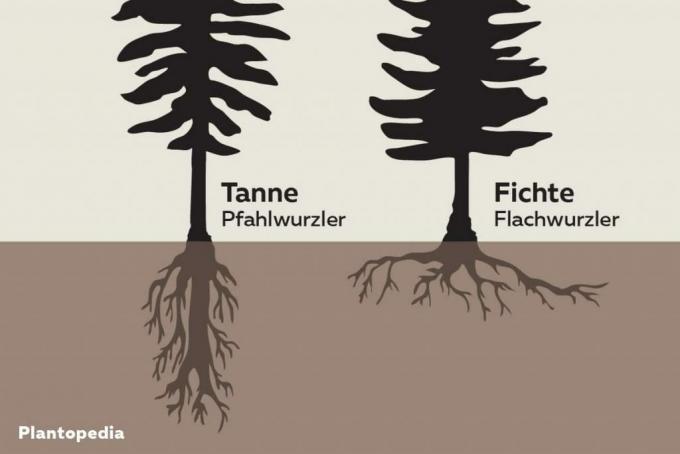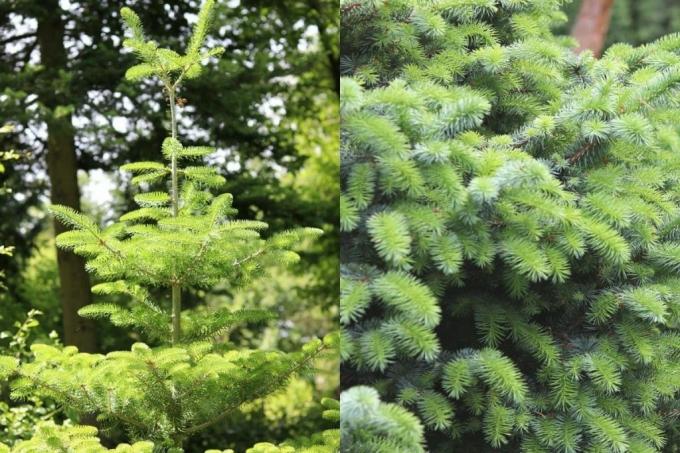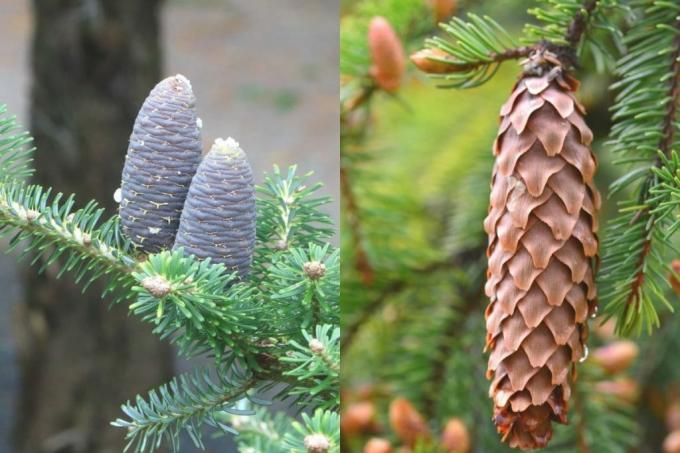
table of contents
- root
- growth
- Needles
- bark
- Cones
- Botanical differences
- frequently asked Questions
The fact that spruce and fir are conifers can be seen at first glance. They also differ from other conifers relatively easily. But it will be difficult for one another. We still have 6 differences between fir and Spruce found.
In a nutshell
- Firs and spruces look very similar
- the most noticeable difference are the cones
- the difference is noticeable with the needles
- different root system difficult to recognize
- Beware of purchased conifers, German names can be deceiving
root
A key difference between fir and spruce is their different root systems. However, since most of them run underground, this is not obvious to many.

| fir | Spruce |
|---|---|
| – Taproot - less susceptible to drought and more storm-proof - can still find water at great depths - is difficult to transplant even at a young age - potted trees hardly grow when planted out |
- shallow roots - not as storm-proof and drought-resistant - can be transplanted more easily - With a little luck, Christmas trees can grow |
Note: Because they are better protected against storms and are more resistant to general global warming, fir trees are preferred today. In comparison, spruce trees also fall prey to pests more quickly.
growth
If fir and spruce grow very similarly in their youth, namely pyramidal-shaped, more and more differences later emerge on closer inspection:

- Fir has horizontal branches
- grow in floors
- The crown of fir trees is lighter
- Spruce aged with a thinner tip
- grows more densely, but it is becoming increasingly thinner due to drought
- Branches form an arch
Needles
Fir trees have rather soft, flat needles that are also blunt at the top. You are on the side branch arranged. Spruce trees have round needles that are pointed at the ends and are so hard that they sting. They grow in a spiral around the branch on a small, brown stem. Pine needles grow green directly out of the branch without stems.

Tip: An important donkey bridge when shopping: the spruce stands out, the fir tree does not.
bark
Conifers can also be distinguished by the color of the bark. Spruce species have reddish bark that turns gray-brown with age. The bark grows like scales.

Fir trees have smoother bark that cracks late. With age it becomes lighter and lighter, up to a whitish color.
Cones
The differences between spruce and fir are also quite clear in the case of the cones. Even if they can be easily distinguished in their shape from the small round cones of larch or pine, there are enough features to recognize them exactly.

| fir | Spruce |
|---|---|
| - Cones grow upright - Fir trees do not shed cones - after ripening only the outer scales of the cones fall off - The tenon spindle remains on the tree |
- Spruce cones hang on the tree - fall off after ripening and lie as whole cones under the tree - Tenon spindles remain when animals have gnawed off the tenons |
Tip: In the case of old trees, a look at the crown or the ground under the conifer is enough to determine the species.
Botanical differences
Both conifers belong to the pine family, but are divided into different subfamilies. The Latin names are derived from this:
- Pine family: Pinaceae
- Subfamily firs: Abietoideae (first part of the botanical name Abies)
- Subfamily spruce: Piceoideae (Picea)
Note: When buying a spruce or fir tree, pay close attention to the botanical name, as the German names can be deceiving. If in doubt, switch to a nursery that knows its way around better.
frequently asked Questions
Usually all conifers change their needles continuously, but imperceptibly. If a lot of needles fall from the tree in winter, either diseases, pests or poor environmental conditions are behind it. As a rule, conifers do not sprout again in the lower trunk area, that is, they are bare.
There are bark beetles for almost every tree species, which can cause lasting damage to the tree under favorable conditions. In spruce trees, the infestation is so noticeable because spruce trees were kept in monocultures for a long time.
On the one hand, of course, because of the softer needles that do not cause any unpleasant stitches when decorating. On the other hand, the needles of fir trees stay longer on the tree after felling than the needles of spruce. If a potted Christmas tree is to be planted in the garden, however, a spruce makes more sense.
Whether fir or spruce, there are different birds that specialize in conifers and are happy when they find some in the garden. Other animals also like to eat the cones.
The characteristics extend to all species and their varieties. A blue spruce may have silvery-bluish needles, but they still stick, while all types of fir, such as the well-known Nordmann fir, have soft needles.



